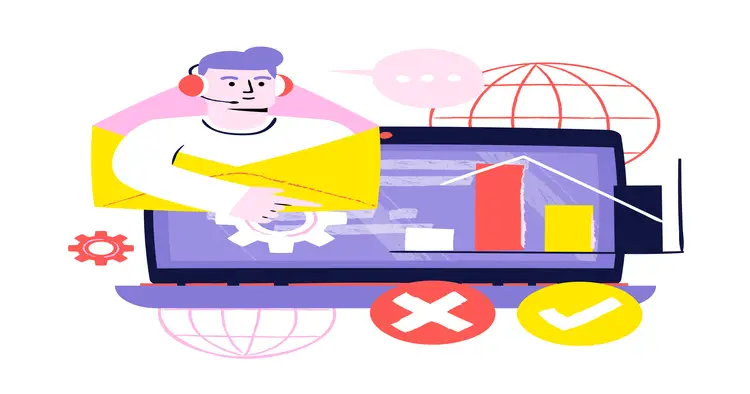Common Mistakes To Avoid In WooCommerce Development
Last Updated | December 1, 2023
Table of Contents
In e-commerce, the pivotal linchpin for achieving success is undoubtedly a meticulously crafted and optimized website. For those traversing the digital marketplace through WooCommerce, a preeminent e-commerce platform, steering clear of common pitfalls that can impede your online store’s performance and growth is paramount. This blog post serves as your compass, illuminating and furnishing invaluable guidance on circumventing these missteps.
Introduction
A finely tuned WooCommerce website isn’t just a boon; it’s a game-changer for your e-commerce enterprise. It doesn’t merely elevate the user experience but also catalyzes increased sales and heightened customer satisfaction. However, the landscape is fraught with pitfalls that can undermine your WooCommerce store’s potential. Let’s delve into these blunders and unravel strategies to navigate around them.
Read Also: How to SetUp Woocommerce in WordPress in 10 Easy Steps
Choosing the Right Hosting Service
Selecting the appropriate hosting service is a linchpin in the intricate realm of WooCommerce development. The ramifications of opting for an unreliable or subpar hosting provider are far-reaching, encompassing issues such as sluggish loading times, frequent downtime, and an overall lackluster performance that can detrimentally impact your online store. To navigate this potential catastrophe successfully, it becomes imperative to prioritize a hosting service that boasts reliability and houses fast servers and robust security measures. The impact of this choice extends far beyond the technical intricacies; it profoundly influences the user experience and, by extension, the very foundation of your bottom line. Consider this decision as an investment in the digital infrastructure that underpins your e-commerce enterprise. Reliability ensures that your online store remains accessible to potential customers at all times, fostering trust and dependability. On the other hand, fast servers contribute to swift page loading times, a crucial factor in retaining visitors and minimizing bounce rates.
Beyond the apparent user-centric benefits, the hosting service’s security measures play a pivotal role in safeguarding sensitive customer data, instilling confidence in your clientele. According to industry studies, e-commerce websites are frequent targets of cyber threats, emphasizing the critical need for robust security protocols. Statistics reveal that websites experiencing downtime for a short duration witness a tangible decline in customer satisfaction, translating into potential revenue loss. The impact on the bottom line is not solely theoretical; it’s substantiated by studies indicating that every additional second of page load time can lead to a significant drop in conversion rates.
In a landscape where online consumers demand instantaneous access and seamless experiences, the technical foundation supporting your WooCommerce store becomes a strategic differentiator. Analyzing industry trends, it’s evident that consumers have increasingly high expectations regarding website performance. Studies indicate that many users abandon a website if it takes more than a few seconds to load. Considering these insights, choosing a hosting service transcends mere technical compatibility; it becomes a fundamental business decision. Opting for a provider with a proven track record in the industry, bolstered by positive client testimonials, is a risk mitigation strategy. As the digital face of your e-commerce venture, the hosting service shapes the first impression for potential customers, influencing their perception of your brand.
Ignoring WooCommerce Updates
Neglecting the imperative of WooCommerce updates constitutes a significant vulnerability in the dynamic landscape of e-commerce. WooCommerce, as a robust system, consistently rolls out updates adorned with essential security patches, bug fixes, and innovative features that can elevate the functionality of your online store. Disregarding these updates is equivalent to leaving the front door of your digital storefront wide open to potential security breaches, presenting an avoidable risk that can compromise sensitive customer data. The significance of staying abreast of WooCommerce updates goes beyond mere adherence to routine maintenance; it’s an investment in fortifying the security and optimizing the performance of your e-commerce platform. Security breaches in the digital realm are not just theoretical concerns; they pose tangible risks to your brand’s credibility and customer base’s trust. Industry reports indicate a rising trend in cyber threats targeting e-commerce websites, underlining the critical importance of staying vigilant through timely updates.
The evolving nature of online threats necessitates a proactive approach. WooCommerce updates are strategically crafted to counter emerging vulnerabilities, making them a crucial component of your defense against potential cyber-attacks. According to cybersecurity studies, many successful cyber incidents exploit known vulnerabilities for which patches are available but haven’t been applied. This underscores the real-world impact of neglecting updates, leaving your online store susceptible to exploitation. Beyond the security imperative, WooCommerce updates introduce novel features and enhancements designed to keep your digital storefront competitive and user-friendly. As technology evolves, customer expectations for seamless online experiences rise in tandem. By embracing updates conscientiously, you not only shield your online store from potential security risks but also position it on the cutting edge of e-commerce innovation, offering customers the latest functionalities and improvements.
The correlation between timely updates and optimized performance is supported by empirical evidence. Studies indicate that websites running outdated software versions experience more significant performance issues, including slower loading times and decreased overall responsiveness. Maintaining optimal performance is a strategic imperative in competitive e-commerce, where user experience directly influences conversion rates and customer retention. Considering the potential ramifications of neglecting updates, it becomes clear that this isn’t merely a routine chore but an investment with far-reaching implications for the longevity and success of your online business. A proactive approach to WooCommerce updates aligns with best practices in risk management and positions your e-commerce venture to thrive in a dynamic digital landscape.
Overlooking Analytics Tools
Refraining from discarding the pivotal role of analytics tools in the current epoch of data-driven decision-making is akin to embarking on a journey without a compass through the vast ocean of customer behavior and sales trends. These tools, exemplified by stalwarts like Google Analytics and WooCommerce Analytics, are not merely navigational aids; they are the essential charts and maps that illuminate the intricate pathways of your online business landscape. Delving into the treasure trove of insights they offer is not just an option; it’s a strategic imperative that can profoundly shape and refine your marketing strategies, product offerings, and overall business direction. In the dynamic realm of e-commerce, where every click and interaction holds valuable information, analytics tools emerge as the linchpin for informed decision-making. According to recent studies, businesses leveraging analytics tools witness a substantial uplift in their overall performance metrics, including conversion rates and customer satisfaction. Understanding the nuances of your website’s performance isn’t just a luxury; a competitive necessity positions your business to navigate the tumultuous waters of the digital marketplace confidently.
Consider this: analytics tools provide granular insights into user behavior, offering a detailed roadmap of how visitors interact with your site. These insights extend beyond page views, encompassing crucial data points such as bounce rates, time spent on pages, and the specific paths users take through your website. This information allows businesses to tailor their user experience, identify pain points, and optimize the customer journey for enhanced engagement. Moreover, analytics tools serve as the cornerstone for deciphering the effectiveness of your marketing strategies. Detailed analytics can pinpoint website traffic sources, allowing businesses to discern which marketing channels yield the highest return on investment. This intelligence empowers data-driven adjustments, ensuring marketing budgets are strategically allocated based on performance data rather than conjecture.
In the competitive landscape of e-commerce, product offerings are a key differentiator. Analytics tools are pivotal in understanding customer preferences, popular product categories, and emerging trends. Armed with this knowledge, businesses can fine-tune their product offerings, ensuring alignment with market demands and maximizing the potential for sales growth. According to industry reports, market trends indicate a rising preference among consumers for personalized and tailored offerings, a realm where analytics tools play an instrumental role. WooCommerce Analytics, as an integral part of the broader analytics landscape, offers e-commerce-specific insights tailored to the intricacies of online retail. This includes detailed information on sales performance, customer behavior, and inventory management. Leveraging these insights enables businesses to optimize their WooCommerce stores for peak performance, ensuring a seamless and satisfying customer shopping experience.
Neglecting Mobile Optimization
The failure to prioritize mobile optimization emerges as a costly oversight for businesses navigating the digital landscape. Many prospective clientele are poised to interact with your website through mobile devices. Overlooking the optimization of your WooCommerce site for mobile usage not only risks delivering a subpar user experience but raises the specter of elevated bounce rates and untapped revenue potential. Therefore, ensuring your website’s responsiveness and guaranteeing seamless navigation and functionality across a diverse array of mobile devices is imperative. The pivotal role of mobile optimization is underscored by the burgeoning prevalence of smartphones and tablets in the hands of consumers. Recent studies reveal a steady upward trajectory in mobile device usage for online activities, with a significant percentage of users preferring the convenience of mobile browsing for product research, price comparisons, and, crucially, completing transactions. The failure to align your WooCommerce site with this mobile-centric trend translates into a missed opportunity to engage with and capture a substantial segment of your target audience.
Consider this: mobile users are known for their penchant for swift and efficient interactions. Research indicates that mobile users exhibit lower tolerance for slow-loading websites, with a delay of just a few seconds, significantly increasing the likelihood of abandonment. Therefore, optimizing your WooCommerce site for mobile responsiveness isn’t merely a technical consideration; it’s a strategic imperative to capture and retain users’ attention in an environment where attention spans are notably fleeting. Moreover, the impact of mobile optimization extends beyond user experience to encompass search engine rankings. Major search engines, including Google, prioritize mobile-friendly websites in their algorithms, recognizing the importance of catering to the mobile-centric preferences of users. A failure to meet these criteria may result in a decline in search engine visibility, diminishing your website’s overall online presence.
Elevated bounce rates, a metric indicating the percentage of visitors who navigate away from a site after viewing only one page, are a potential consequence of neglecting mobile optimization. Studies demonstrate a direct correlation between mobile-unfriendly websites and increased bounce rates, signifying the immediate negative impact on user engagement and potential conversion opportunities. In e-commerce, where conversion rates are paramount, minimizing bounce rates becomes integral to optimizing revenue streams.
Furthermore, the financial ramifications of neglecting mobile optimization are tangible. As mobile commerce continues to carve a larger slice of the e-commerce revenue pie, businesses that fail to deliver a seamless mobile experience risk leaving revenue on the table. Market projections highlight the exponential growth of mobile commerce transactions, underlining the financial incentives for businesses that invest in robust mobile optimization strategies. Ensuring essential responsiveness and a harmonious and intuitive user experience across many mobile devices is the cornerstone of successful optimization. The diverse landscape of mobile devices, ranging from smartphones to tablets with varying screen sizes and resolutions, necessitates a comprehensive approach. Utilizing responsive design principles, optimizing images for mobile viewing, and streamlining the checkout process for mobile users are essential components of a robust mobile optimization strategy.
Overlooking SEO Settings
In the intricate web of online retail, the significance of search engine optimization (SEO) transcends mere digital strategy—it serves as the beacon that guides potential customers to your virtual storefront. The ramifications of disregarding SEO settings are akin to dimming this crucial beacon, making your website less visible in the vast expanse of search engine results. To harness the full potential of your WooCommerce site, it is imperative to leverage its built-in SEO features, encompassing customizable URLs, meta tags, and XML sitemaps. These tools form the cornerstone of an effective SEO strategy, propelling your online presence to ascend the ranks of search engine results. Elevating your online visibility isn’t just a technical nuance; it is a pivotal factor for attracting organic traffic and expanding your customer base.
The labyrinth of online retail is navigated by consumers through search engines, with a significant percentage relying on search queries to discover new products, services, and businesses. Statistics highlight the exponential growth of online searches as a precursor to purchasing decisions, underlining the critical role SEO plays in ensuring your virtual storefront isn’t lost in the digital noise. Consider this: According to industry studies, most online experiences commence with a search engine query, making the search engine results page (SERP) the initial point of contact for potential customers. The effectiveness of your SEO strategy directly influences your website’s visibility on this page. Disregarding SEO settings is diminishing your presence on this crucial digital stage, reducing the likelihood of being discovered by users actively seeking products or services that align with your offerings.
WooCommerce, as a robust e-commerce platform, is equipped with a suite of SEO features designed to empower businesses in their quest for enhanced online visibility. Customizable URLs provide a unique opportunity to incorporate relevant keywords, improving the likelihood of your pages ranking higher in search results. Meta tags, encompassing titles and descriptions, not only communicate the relevance of your content to search engines but also serve as the snippet users see on the SERP, influencing their decision to click through to your site. On the other hand, XML sitemaps facilitate search engine crawlers in comprehensively indexing your site, ensuring that all relevant pages are considered in the ranking algorithm.
The correlation between enhanced online visibility and organic traffic is well-established. Studies reveal a direct link between higher search engine rankings and increased click-through rates, with the first page of search results receiving the majority of clicks. The strategic utilization of WooCommerce’s SEO features positions your website to secure a spot on this prime real estate, capturing the attention of users actively seeking products or services in your niche. Moreover, the impact of SEO extends beyond the immediate visibility on search engines to long-term brand credibility. Consistent appearances at the top of search results signal to users that your business is a trusted authority in its domain, fostering trust and brand loyalty. Studies indicate that users associate higher search rankings with credibility and reliability, influencing their purchasing decisions.
Conclusion
Steering clear of common pitfalls in WooCommerce development is the linchpin for constructing a flourishing e-commerce enterprise. By embracing a reliable hosting service, staying attuned to WooCommerce updates, harnessing analytics tools, prioritizing mobile optimization, and optimizing SEO settings, you unlock the full potential of your WooCommerce website. Remember, a well-forged WooCommerce store lays the groundwork for growth, sales, and unparalleled customer satisfaction.
As you embark on your WooCommerce development journey, remember these insights to foster a resilient and thriving online presence. Happy development! So, whether you’re a seasoned entrepreneur or a budding e-commerce enthusiast, let these tips serve as the wind in your sails, propelling your WooCommerce store toward unprecedented success.
In the realm of WooCommerce development, the company poised to transform your e-commerce aspirations into reality is Folio3. With a track record of delivering cutting-edge solutions, Folio3 emerges as the beacon guiding your journey through the intricate landscape of online commerce. Trust in Folio3, your steadfast companion on the path to WooCommerce excellence.
Read Also: How to Customize WooCommerce Shop Page – Best Practices
FAQ’s:
Question 1: What are the most common mistakes in WooCommerce development, and how can they be avoided?
Common mistakes in WooCommerce development include inadequate product categorization, poor mobile optimization, and overlooking security measures. To avoid these, prioritize proper planning, stay updated on best practices, and conduct thorough testing throughout development.
Question 2: Is using too many plugins in a WooCommerce store a mistake?
Yes, relying on an excessive number of plugins can lead to performance issues, conflicts, and security vulnerabilities. It’s essential to carefully select and limit plugins to only those necessary for your site’s functionality, ensuring a streamlined and efficient online store.
Question 3: How can one avoid slow loading times in a WooCommerce store, and why is it crucial?
Slow loading times often result from large images, unoptimized code, or server issues. To prevent this, optimize images, implement caching, and choose a reliable hosting provider. Speed is crucial for user experience and can significantly impact conversion and search engine rankings.
Question 4: Are there specific design mistakes that developers commonly make in WooCommerce stores?
Common design mistakes include cluttered layouts, confusing navigation, and inconsistent branding. Avoid these issues by prioritizing a clean and user-friendly design, ensuring your customers a seamless and enjoyable shopping experience.
Question 5: How important is ongoing maintenance in WooCommerce development, and what mistakes should be avoided during this phase?
Ongoing maintenance is crucial for keeping a WooCommerce store secure and optimized. Make sure to pay attention to updates, backups, and security measures. Regularly update themes, plugins, and the WooCommerce core to benefit from new features, bug fixes, and enhanced security.









